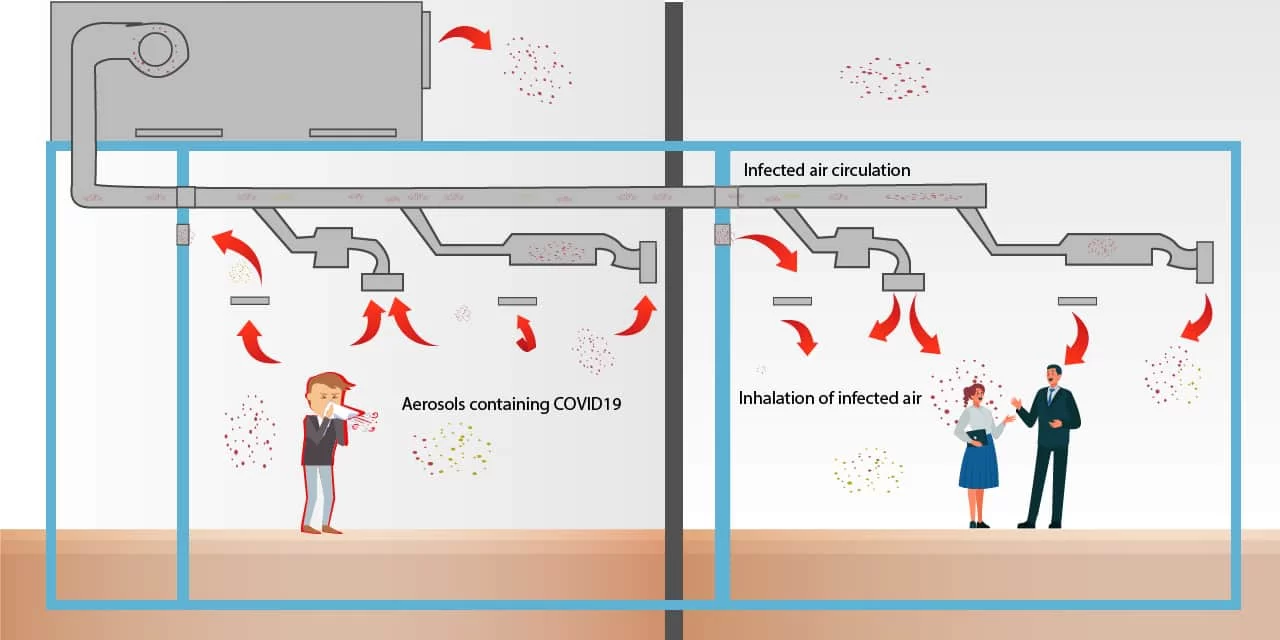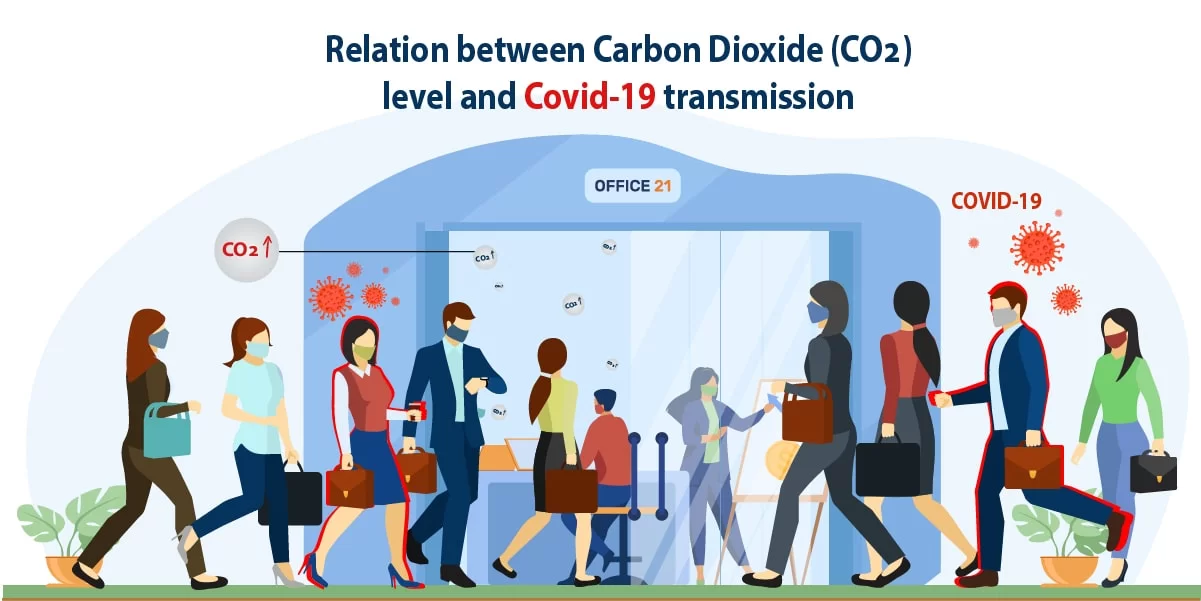The rise of carbon dioxide (co2) levels in indoor air can negatively impact the transmission of COVID19 and human health. Carbon Dioxide is the most important parameter for Indoor Air Quality as it has significant effects on human body. Mostly, 90% of time people are present in houses, offices, schools, restaurants etc and high levels can hinder with the working capability of employees.
The Covid-19 Pandemic is a global terror
Covid-19 is a pandemic since December 2019 and we all know its transmission mode is through air. We all know that the transmission can be prevented with the use of masks, sanitizer, social distancing and continuous washing of hands in outdoor environment but do we know how to stop the transmission in indoor environment?
Approximately 19,55,42,719 people infections and 41,87,056 morbidities are seen worldwide since the pandemic. The most common symptoms of infection are fever, dry cough and tiredness. Less common symptoms are ache, sore throat, diarrhea, conjunctivitis, skin rash and discoloration of toes and fingers.
During past few months, researches are trying hard to find ways to monitor COVID-19 infection risk indoors. Some countries are working towards the development of instruments which will detect the presence of virus in air continually. However, these instruments will be highly expensive.
Effects of Indoor Air Quality (IAQ) on human health
The quality of air present within closed structures such as buildings, offices, schools, hospitals etc is called Indoor Air Quality. When air is contamination free or no pollutants are present, it is considered as healthy. Outdoor Air Quality is affected by various human activities like excess vehicular emissions, industrial emissions, smoking, constructions etc. The death toll from Indoor Air Pollution is rising.
According to WHO, 3.8 million deaths are caused by indoor air pollution out of which 6% are in Low Income Countries.
Bad IAQ can be ten times more hazardous than the outdoor air quality. The bad quality of air can show negative human health impacts because most of the times people are present in their houses, schools and offices. The parameters that decide the IAQ are Carbon Dioxide, Particulate Matter, TVOCs, ozone, HCHO and carbon monoxide. Out of these parameters, the most important parameter is CO2 as it can interferes with the working speed, decision making and productivity of worker.
People experience common health effects such as eyes, skin, nose and throat irritation, fatigue, emphysema, asthma, breathing difficulties, suffocation, upper respiratory congestion, headache and dizziness due to indoor air pollution. Absenteeism in offices and schools is linked with high levels of carbon dioxide. Ventilation is advised for regular movement between indoor and outdoor air to prevent these health effects.
Offices un-lockdowns and increasing risk of infection due to Carbon Dioxide (CO2)
The major concern developing these days is about opening of office spaces after lockdown. People come from different regions and chances of them being infected are high. The mass gathering in office spaces will increase chances of covid-19 infection. The average exhalation rate of CO2 per person is about 8 litres of air per minute. Along with this exhalation, tiny droplets are also released in air which is the main cause of covid-19 transmission. This infected air circulates in building through ventilation system leading to high risk of covid-19. Currently, only cost effective method to monitor covid-19 transmission is continuous CO2 monitoring in office buildings, installation of HVAC system, following up with proper BMS (Building Management System).

Circulation of infected air from one compartment to the other increasing transmission of covid-19 in building
In indoor environment, Carbon dioxide levels depend upon the number of people occupying space. The type of physical activity performed by occupants is directly linked with gaseous exhalation. For example, a person running on treadmill in a gym will have higher respiration rate than others. Similarly if 10 people are running at the same time, the overall respiration rate will increase. The level of CO2 increases with increase in intensity of physical activity. This causes more discomfort to other occupants.
What do recent trends and researches say about carbon dioxide (CO2) and covid-19 transmission?
In 2003, Rudnick and Milton gave a model which estimated the relation between CO2 levels and air transmission of influenza virus. The recent studies have shown direct relation between carbon dioxide levels and covid- 19 transmission. One model showed that when CO2 level drops from 2800 ppm to 1000 ppm the transmission risk also reduced to one quarter of native transmission and when influx is increased the transmission rate gets tripled.
A recent study from Cooperative Institute for Research in Environmental Sciences and University of Colorado Boulder has shown that when the level of carbon dioxide doubles in indoor environment, the risk of covid-19 transmission also doubles roughly. Researchers from Department of Chemical Engineering, Massachusetts Institute of Technology showed relations between exposure time and pathogen concentration.
A study from SAGE-EMG (Environmental Modeling Group of UK’s Scientific Advisory for Emergencies) showed that the risk of covid-19 is increased only with increase in exhaled CO2. Other factors such as combustion, biomass burning etc. that leads to increased level does not affect covid-19 transmission. Activities such as speaking and singing by people in enclosed spaces increases risk of covid-19 transmission. If there are less number of occupants in closed spaces like offices and schools, carbon dioxide monitoring will not help in reducing risk of Covid-19 transmission.
Italian Government with European countries and WHO came up with adequate ventilation as a contingency plan. Research group from Laboratory of environmental sustainable at department of biology of University of Bari (Italy) and Italian Society of Environmental Medicine conducted a classroom survey in which they identified the link between carbon dioxide, ventilation, space area and covid-19 transmission. The survey showed that re-inhalation of contaminated exhaled air increases the risk of covid-19 transmission.
Indoor and Outdoor Covid-19 transmission is different
Most people practice preventive measures like social distancing, covering the faces, using sanitizers, avoiding close contacts etc. when stepping out. Have you ever considered taking these precautions in your houses or offices? The risk of virus transmission increases in closed environments due to its direct link with exhaled CO2.
The infection spreads when an infected person coughs, sneezes or talks with non-infected person without covering the face. The continuous movement of air in outdoor environment washes away these droplets and this reduces the risk.

Ventilation is poor in indoor leading to high CO2 levels than outdoors where pollutants are washed away.
The problem occurs in indoor areas where ventilation is poor. Poor Ventilation along with floor volume, number of occupants and the duration of their occupancy affects the transmission rate. Carbon dioxide level increases with increase in number of people and their stay time. Researches have now suggested that the chances of infection reduce massively in outdoors.
Indoor Carbon Dioxide (CO2) measurement as a biomarker
A process of oxygen inhalation and carbon exhalation is termed as respiration. It also results in release of droplets and aerosols. The physical activity performed by an individual determines the intensity of exhaled air.
The size of aerosol can directly affect the transmission. The small aerosols are lighter in weight and this adds an advantage to their stay in air. Heavy aerosols settle down easily and quickly in influence of gravity. Other than this, physical parameters such as ambient air temperature, relative humidity and intensity of fluid turbulence also affects the stay of suspended aerosols in air. The reduction in space and increase in number of people also affects air transmission.
There is no other source of viral aerosols apart from human beings in buildings or offices. Occupant’s respiratory activities are primary source of CO2 generation. The concentration of exhaled air is much higher than environmental concentration. Areas which are highly occupied with low ventilation rate and the sole source of CO2 is human beings can use CO2 as biomarker.
Impacts of Exhaled Droplets are Dangerous
Human activities like exhalation, speaking, singing etc. releases tiny droplets and these droplets vary in size from 0.01 to 1000 um. Respiratory droplets and aerosols are different from each other in size. Respiratory droplets have size of 5-10 um whereas aerosols have size of less than 5 um.
These droplets are capable to sustain in air for quite period of time and the evaporation of these droplets solely depends upon its composition and temperature & relative humidity of surrounded air. Evidences have shown droplets from exhaled suspended indoor air as potential risk of transmitting covid-19.
Symptomatic and asymptomatic people contributes equally in transmitting the virus. However, a person’s spreading capability of infection is higher before the onset of symptoms. Some people might say that the viral load and droplets size is related but the relationship between viral load and droplet size is still unknown.
The evidences are already present that show the transmission of covid-19 is through air and occurs when person inhales the infected aerosols and droplets. With regular surface cleaning, disinfecting and social distancing in indoors can prevent transmission. Some studies showed social distancing of about 18 feet between patients in a hospital couldn’t reduce the infection. However, it shows that the transmission mode of covid-19 is through infected aerosols.
Results have also shown that being at a distance of 1.5m from aerosol emitter having diameter of 0.3 um, the aerosol can enters in fresh air ventilation system leading to the contamination of whole building and increasing the risk of virus infection.
Perks of exposing yourself to fresh air
There are many benefits and perks of exposing yourself to fresh air.
1. Fresh air increases ventilation and can avert the viral infection. Opening up of doors and windows in houses can help in increasing ventilation.
2. Reduction in use of Air Conditioning systems and increasing the use of normal fans help in reducing viral infection.
3. Replacement of stale air with fresh air can lead to reducing covid-19 infection risk.
4. Fresh air also improves blood pressure & digestion problems. It also aids in stress and boosts immunity.
5. Diluting indoor air with outdoor air reduces concentration of airborne contaminants such as viruses and bacteria and surface contaminants.
Guidelines and solutions to limit virus transmission
Guidelines laid by World Health Organization (WHO) for preventing spread of coronavirus involve practicing social distancing, covering nose and mouth area with face masks, washing of hands regularly, avoiding surface touching and physical contacts. These measures are practiced by all in outdoor environment, however, the chances are high for getting infected in indoors. The most cost effective method to prevent indoor disease spread is proper ventilation and monitoring of carbon dioxide.
Ventilation is a preventive method that anyone can adopt in their houses. The size of exhaled aerosols plays a major role in transmission and it is necessary to reduce its concentration. Small sized aerosols can easily sustain in air for longer duration & distance and they might even contaminate surfaces. Large sized aerosols can easily carry the virus with themselves and this will increase the chances of virus infection.
Viruses are capable to thrive in low air temperature and humidity. Low humidity helps airborne contaminants to travel easily through air. Controlling temperature and humidity of air in indoor environment will affect surviving of virus in air and reduce infection risk.
Controlling ventilation according to number of people occupying indoor spaces will decrease risk of virus infection. Ventilating the house while cleaning and disinfecting will reduce infection risk caused by re-suspended viral aerosols. According to ASHRAE, using portable HEPA air cleaners can help in removing airborne particles containing virus. The removal of bioburden is necessary before the entry of occupants and after their exit.







